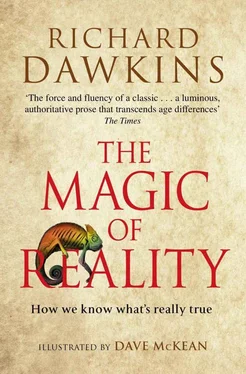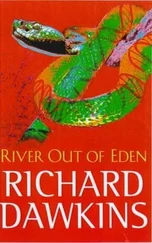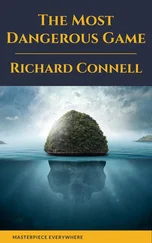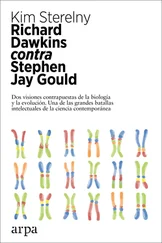The two myths just described may have begun with particular earthquakes in history. There are also lots of other myths, from all around the world, that have come into being as people have tried to understand what earthquakes are in general.
Since Japan experiences so many earthquakes, it’s not surprising that Japan has some pretty colourful earthquake myths. According to one of these, the land floated on the back of a gigantic catfish called Namazu. Whenever Namazu flipped his tail, the Earth would shake.
Many thousands of miles south, the Maoris of New Zealand, who arrived by canoe and settled there a few centuries before European sailors arrived, believed that Mother Earth was pregnant with her child, the god Ru. Whenever baby Ru kicked or stretched inside his mother’s womb, there was an earthquake.
Back in the north, some Siberian tribes believed that the Earth sat on a sledge, pulled by dogs and driven by a god called Tull. The poor dogs had fleas, and when they scratched there an earthquake.
In one West African legend, the Earth is a disc, held up on one side by a great mountain and on the other side by a monstrous giant, whose wife holds up the sky. Every so often the giant and his wife hug each other, and then, as you can well imagine, the Earth moves.
Other West African tribes believed that they lived on top of a giant’s head. The forest was his hair, and the people and animals were like fleas wandering around on his head. Earthquakes were what happened when the giant sneezed. At least, that is what they were supposed to believe, though I rather doubt they really did.
Nowadays we know what earthquakes really are, and it is time to put away the myths and look at the truth.
What earthquakes really are
First, we need to hear the remarkable story of plate tectonics.
Everybody knows what a map of the world looks like. We know the shape of Africa and the shape of South America, and we know that the wide Atlantic Ocean separates them. We can all recognize Australia, and we know that New Zealand lies to the south-east of Australia. We know that Italy looks like a boot, about to kick the ‘football’ of Sicily, and some people think New Guinea looks like a bird. We can easily recognize the outline of Europe, even though the borders within it change all the time. Empires come and go; the frontiers between countries are shifted again and again through history. But the outlines of the continents themselves stay fixed. Don’t they? Well, no, they don’t, and that is the big point. They move, although admittedly very slowly, and so do the positions of the mountain ranges: the Alps, the Himalayas, the Andes, the Rockies. To be sure, these great geographical features are fixed on the timescale of human history. But the Earth itself – if it could think – would think that no time at all. Written history goes back only about 5,000 years. Go back a million years (that’s 200 times as far back as written history stretches) and the continents all have pretty much the same shapes they do today, as far as our eyes would notice. But go back 100 million years and what do we see?
The South Atlantic Ocean was a narrow channel by comparison with today, and it looks as though you could almost have swum from Africa to South America. Northern Europe was nearly touching Greenland, which was nearly touching Canada. And India was not part of Asia at all, but right down by Madagascar, and tilted on its side. Africa lurched over the same way, too, compared with the more upright stance we see today.
Come to think of it, did you ever notice, when looking at a modern map, that the eastern side of South America looks suspiciously like the western side of Africa, as though they ‘wanted’ to fit together, like pieces in a jigsaw puzzle? It turns out that, if we go back a bit further in time (well, about 50 million years further back, but even that is just ‘a bit’ on the vast, slow geological timescale), we find that they actually did fit together.
One hundred and fifty million years ago, Africa and South America were completely joined up, not just to each other but to Madagascar, India and Antarctica too – and to Australia and New Zealand, round the other side of Antarctica. They were all one big land mass called Gondwana, which later split up into pieces, creating one daughter continent after another.
It sounds like a pretty tall story, doesn’t it? I mean, it sounds pretty ridiculous that anything as massive as a continent could move thousands of miles – but we now know that it happened, and what is more, we understand how.
We also know that the continents don’t only move away from each other. Sometimes they bump into each other, and when that happens huge mountain ranges get pushed up towards the sky. That’s how the Himalayas were formed: when India collided with Asia. Actually, it isn’t quite true that India collided with Asia. As we shall see soon, what collided with Asia was a much bigger thing, called a ‘plate’, much of it under water, with India sitting on top of it. All continents sit on these ‘plates’. We’ll come to them soon, but first let’s think a bit more about these ‘collisions’, and about the continents moving apart.
When you hear a word like ‘collided’ you might think of a sudden crash, as when a truck collides with a car. That isn’t the way it was – and is. The movement of the continents happens agonizingly slowly. Somebody once said it happens about as fast as fingernails grow. If you sit and stare at your fingernails, you don’t see them growing. But if you wait a few weeks, you can see that they have grown, and you need to cut them. In the same way, you can’t see South America in the act of moving away from Africa. But if you wait 50 million years, you notice that the two continents have moved a long way apart.
‘The speed with which fingernails grow’ is the average speed at which the continents move. But fingernails grow at a pretty constant speed, whereas the continents move in jerks: there’s a jerk, then a pause of a hundred years or so while the pressure to move again builds up, then another jerk, and so on.
Perhaps now you are beginning to guess what earthquakes really are? That’s right: an earthquake is what we feel when one of those jerks happens.
I’m telling you this as a known fact, but how do we know it? And when did we first discover it? That’s a fascinating story, which I now need to tell.
Various people in the past have noticed the jigsawy kind of fit between South America and Africa, but they didn’t know what to make of it. About 100 years ago, a German scientist called Alfred Wegener made a bold suggestion. It was so bold that most people thought he was a bit mad. Wegener suggested that the continents drifted about like gigantic ships. Africa and South America and the other great southern land masses had, in Wegener’s view, once been joined together. Then they tore apart from each other and cruised off through the sea in their separate directions. That was what Wegener thought, and people laughed at him for it. But it now turns out that he was right – well, almost right, and certainly much more right than the people who laughed at him.
The modern theory of plate tectonics, which is supported by a huge amount of evidence, isn’t quite the same as Wegener’s idea. Wegener was definitely right that Africa and South America, India, Madagascar, Antarctica and Australia had once all been joined up and later split apart. But the way it happened, according to the theory of plate tectonics, is a bit different from the way Wegener saw it. He thought of the continents as ploughing through the sea, floating, not on water but on the soft, molten or semi-molten layers of the Earth’s crust. The modern theory of plate tectonics sees the whole crust of the Earth, including the bottom of the sea, as a complete set of interlocking plates. (That’s ‘plates’ as in ‘armour plates’, not the kind of plates you eat off.) So it isn’t just the continents that move: it’s the plates that they sit on, and there is no bit of the Earth’s surface that isn’t part of a plate.
Читать дальше











